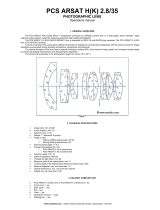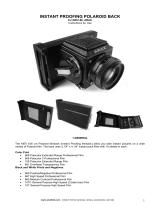Page is loading ...

www.araxfoto.com - medium format cameras, lenses, accessories, services
TS ARAX 2.8/35
PHOTOGRAPHIC LENS
Operations manual
1. GENERAL GUDIELINES
The TS ARAX 2,8/35 (TS = Tilt Shift) camera compact lens with tilt and shift movements is a wide-angle, eleven element large
aperture optical system, suited for producing extremely high quality photographs. The effects of large-format camera movements can be
obtained with TS ARAX lenses for 35mm cameras.
The TS ARAX 2,8/35 lens is available for 35mm type cameras:
· Nikon AI
· Canon EOS
· Canon FD
· Minolta Dynax
· Minolta MD
· Pentax K
· M42 (Zenit, Practica, etc.)
· Olympus OM1 ... OM3
· Contax
· Yashica
· Leica R
· Rolleyflex
In terms of structure the optical block tilTShifting mechanism is designed to provide the photographer with the power correct the
image distortions encountered during shooting architecture, panoramas, and products.
The optical elements of the lens have a special multi-layer coating (МС), they improve image quality and increase contrast range
by enhancing integral transmission and decreasing the dispersion.
The camera lens operates in the temperature range from minus 15 to 45° С.
2. TECHNICAL SPECIFICATIONS
· Image ratio, mm: 24х36
· Focal distance, mm: 35
· Aperture ratio: 1:2,8
· Design: 11 elements, 8 groups
· Angle of view:
o Without shifting optical block: 67
o
20'
o Having shifting optical block: 80
о
· Short focusing range, m: 0,3
· Aperture range: 2,8 - 22
· Aperture operation: Manual
· Threads for light filters, mm: 62
· Maximum shift of the optical block, mm: 11
· Maximum tilt of the optical block, mm: 8
· Turning angle of the optical block relative to bayonet axis: 360
о
· Maximal diameter, mm, not more than: 72
· Overall dimensions, mm, not more than: 82х85
· Weight, kg, not more than: 0,65
Figure 1 Figure 2

www.araxfoto.com - medium format cameras, lenses, accessories, services
Figure 3
1. Focusing ring
2. Distance scale
3. Deep of field scale
4. Aperture scale
5. Aperture ring
6. TS plate
7. Tilt handle
8. Tilt scale
9. 360
о
rotating ring
10. Shift handle
11. Shift scale
3. OPERATIONS INSTRUCTIONS
3.1. Lens installation on the camera and its removal
Install and remove the lens as it written in the camera’s operation manual.
3.2 Focusing
It is preferable to perform focusing at maximum aperture by rotating the focusing ring 1, on which focusing scale (distance) 2 is
marked. If focusing is required after tilting and shifting the optical block, then the microprisms or camera viewfinder wedges’ surface dim
out. In this case it is necessary to control image sharpness according to the screen’s matte area. The distance scale 2 can be used
instead to give an approximate focus.
During optical block tilting and shifting, decrease the aperture as far as possible, because unequal amounts of the light falls on the
edges and center of the field. It is recommended to use the aperture values from 16 to 22.
When focusing the lens after it has been shifted, it is possible that the microprism and the split-image rangefinder of the viewfinder
of the camera may darken. In that case, check the image sharpness on the matte spot of the focusing screen. Orientation based on a
distance scale after the lens has been shifted shall not give precise result.
3.3. Aperture operation
Manual aperture operation is provided for in the lens. Select the value by rotation of the ring 5, first pulling it aside along the optical
axis towards the camera. In the released condition rotate the ring 5 from set up value to the value 2,8. Before exposure do not forget to
rotate the ring 5 until the selected value of the aperture appears.
3.4. Lens shifting
While rotating handle 10, the lens is moving in parallel to the image surface. The lens can be rotated by 360
о
with settled interval
every 30
о
(the lens can operate even in the positions between these intervals). Due to the fact that the camera’s image is rectangular,
the limit degree of lens shift will be changing at every rotation. The maximal shift is possible at the settled position of the lens along the
image’s short side. Control this shift on the scale 11.
3.5. Lens tilting
While rotating tilting handle 7, the lens is tilting. Tilting depends from the direction of rotation of tilting handle 7. The lens can be
rotated by 360
о
with settled interval every 30
о
(the lens can operate even in the positions between these intervals). Due to the fact that
the camera’s image is rectangular, the limit degree of lens tilt will be changing at every rotation. The maximal tilt is possible at the
settled position of the lens along the image’s short side. Control this shift on the scale 9. Remember that it is recommended to set up the
tilt angle with the zero position of the shift.
Tilting during photographing, obey the Scheimpflug principal, which states that if a lens is tilted such that the lens plane intersects
the film plane, the plane of sharp focus must also pass through that same line of intersection like it shown on the scheme below.

www.araxfoto.com - medium format cameras, lenses, accessories, services
3.6. Lens rotating
The lens can be rotated by 360
о
with settled interval every 30
о
(the lens can operate even in the positions between these
intervals). For 360
o
lens rotating just rotate the ring 9 clockwise or counter-clockwise. When lens installed on the camera body, you can
rotate them also holding lens body or TS plate 6.
3.7. Distortion correction
When photographing high buildings from ground level, the distances from the lens from the top and bottom of the subject are
radically different. As a result of this, the distortion in this case appears as a convergence of the parallel lines upwards (Figure 4), and
vice versa: when photographing from above downwards, the parallel sides of the building will be converging downwards.
Figure 4
In order to correct such distortion do not incline the camera either upwards or downwards, but maintain the film plane in parallel
to the object being photographed (for example, building), thus that film plane of the camera is situated at right angles to the ground.
Then, in order to achieve the intended composition the optical block of the lens shall be shifted vertically upwards, due to this the
distortion is eliminated. See Figure 5.
Figure 5
Sometimes instead of image correction, with the intention of creating special effects, the occasion arises to create even more
exaggerated distortions. In this case, you would incline the camera upwards and shift the lens in the opposite direction.
3.8. Reflection elimination
When photographing objects with reflective surfaces, the reflection of the photographer along with camera can appear on the
image. (Figure 6А). Carrying over the camera angle to one side and shifting the lens to the opposite side, while retaining the parallelism
of the object and film planes allows you to eliminate the reflection and still preserve the rectangular composition of the image (Figure
6B).
Figure 6А Figure 6B

www.araxfoto.com - medium format cameras, lenses, accessories, services
3.9. Panoramas
While using a lens with shift capability you can produce panoramic photographs. For that, make two exposures from one camera
angle: first one – with maximum shift of the lens to the right, and a second one – with maximum shift to the left. Combining both images
will provide you with a single panoramic photograph (Figure 7), which corresponds to a negative with an image format of 6х9 сm and
normal perspective.
Figure 7
3.10. Obstruction elimination
Obstructions like trees or telegraph poles located relatively closely to the camera and appearing at the image edge can be
eliminated by means of lens shifting and rotating the camera.
For instance, the obstruction (pole) is located at the image edge on the right. See Figure 8А. To eliminate it, shift the lens to the
right, and rotate the camera to the left until full disappearance of the pole. (Figure 8B).
Figure 8А Figure 8B
4. STORAGE AND MAINTENANCE RULES
The camera lens is a complicated optical device and it requires careful operation and maintenance. Protect it against impacts,
sudden fluctuations in temperature and also against dust and moisture.
Upon entrance into a warm room from outside frost do not open the lens immediately. Let it warm up to prevent condensation on
the optical surfaces.
Remove dust and moisture from the lens with a soft brush, cloth, or a product specific to this purpose.
Note: During inspection it can be found out that some lenses may have small bubbles in the glass, insignificant scratches and fluffs
which do not in any way affect image quality and have been accepted by the ARAX standard.
Version 2 (07-26-2011)
ARAX Inc.
Kiev, Ukraine, 01042
www.araxfoto.com
info@araxfoto.com
/









